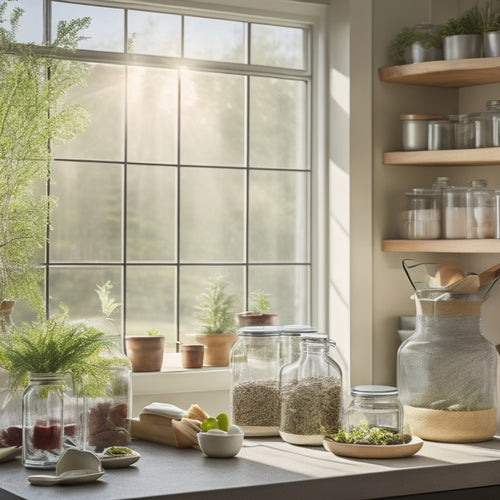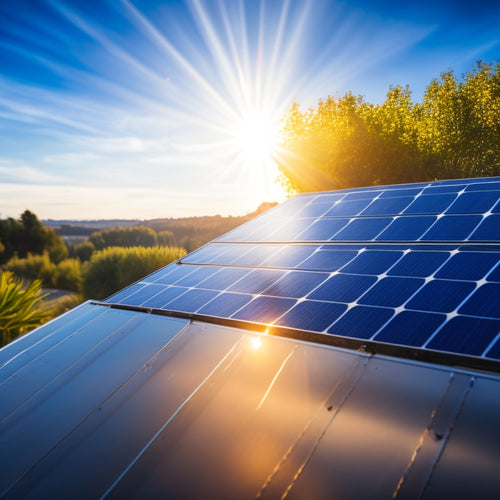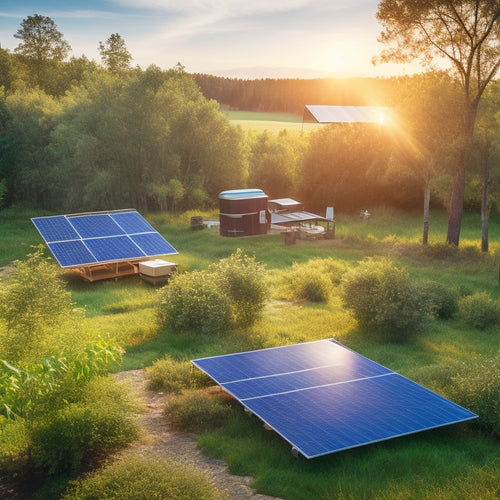
5 Tips for Home Water Pump Independence
Share
You'll need to assess your water pump needs by evaluating your home's unique requirements, including water source, distance, and fixture count. Then, choose the right solar panel type, considering efficiency and budget. Next, select an inverter that's compatible with your panel's power output. Properly sizing your system is vital, so calculate your daily water usage, well depth, and pipe diameter. Finally, monitor key performance metrics and maintain your equipment to guarantee reliable operation. By following these steps, you'll be well on your way to achieving water pump independence, and a more in-depth exploration of each of these areas will reveal even more opportunities for optimization.
Overview
- Assess your water source and pumping needs to determine the ideal pump size and type for reliable water supply independence.
- Choose the right solar panel type and number for your system, considering efficiency, cost, and installation guidelines for optimal energy production.
- Select a compatible inverter that efficiently converts solar power, minimizing energy losses and ensuring seamless energy conversion.
- Ensure proper system sizing by considering daily water usage, well depth, and pipe diameter to optimize system efficiency and prolong equipment life.
- Regularly monitor and maintain your system's performance to detect potential issues early, preventing escalation into major problems.
Assess Your Water Pump Needs
When selecting a water pump for your home, one of the most critical steps is to accurately assess your water pump needs.
You'll need to conduct a thorough water source assessment to determine the required flow rate, pressure, and volume of water. This involves evaluating the distance from the water source to your home, as well as the number of fixtures and appliances that will be using the water.
Considering the benefits of solar energy for rural water pumping systems, such as energy independence, can also help you make an informed decision. Additionally, recognizing the importance of reliable water supply in remote areas can guide your choice.
Next, perform a pump efficiency evaluation to determine the ideal pump size and type for your specific needs.
Consider factors such as head pressure, flow rate, and power consumption to guarantee you choose a pump that will meet your demands while minimizing energy costs.
Choose the Right Solar Panel
Fewer than five solar panels are often needed to power a standard residential water pumping system, but selecting the right one is crucial to guarantee peak performance and energy efficiency.
When choosing a solar panel, you'll need to evaluate the type that suits your system best. Monocrystalline, polycrystalline, and thin-film solar panels are the most common types. Monocrystalline panels offer the highest efficiency, while polycrystalline panels provide a balance between efficiency and cost. Thin-film panels are the most budget-friendly option but have lower efficiency.
Solar water pumping solutions, such as off-grid solar solutions, can improve irrigation and water supply, reducing fossil fuel reliance. Additionally, decentralized energy distribution can tailor energy supply to community needs, making solar panels a significant component.
Confirm you follow installation guidelines, such as orienting panels at a prime angle and providing adequate spacing for airflow, to maximize energy production and reduce maintenance needs.
Select a Compatible Inverter Type
Two key components of a solar water pumping system - the solar panel and the inverter - must work in harmony to guarantee seamless energy conversion and efficient water pumping.
When selecting an inverter, you'll want to verify it's compatible with your solar panel's power output. Look for an inverter with high inverter efficiency (above 95%) to minimize energy losses.
It's also vital to take into account the inverter's compatibility with your battery chemistry, voltage, and charging requirements inverter compatibility and selection, as mismatched components can lead to system failure.
You'll also need to evaluate power compatibility, confirming the inverter can handle the maximum power output of your solar panel.
A compatible inverter will optimize your system's performance, reducing energy waste and maximizing your water pumping needs.
Ensure Proper System Sizing
Properly sizing your solar water pumping system is vital to meeting your water needs efficiently.
You'll want to take into account factors like your daily water usage, well depth, and pipe diameter to guarantee your system can handle the demands. A correctly sized system will optimize system efficiency, reducing energy waste and prolonging the life of your equipment.
Pressure regulation is also critical, as it prevents excessive pressure from damaging your pipes and pump. By accurately calculating your system's requirements, you'll be able to select the right pump, motor, and controller for your specific needs.
This attention to detail will give you the freedom to enjoy a reliable and efficient water supply, without relying on municipal utilities.
Monitor and Maintain Performance
By regularly tracking your solar water pumping system's performance, you'll be able to identify potential issues before they escalate into major problems.
To do this, focus on key performance indicators such as flow rate, pressure, and energy consumption. By monitoring these metrics, you'll be able to detect subtle changes that could indicate a problem.
In addition to tracking performance indicators, perform routine inspections of the system to identify any signs of wear or damage. Check the condition of pipes, fittings, and valves, as well as the solar panels and pumping equipment.
Frequently Asked Questions
Can I Use a Single Solar Panel for Multiple Water Pumps?
You'll need to determine if a single solar panel can handle multiple water pumps by calculating the solar panel capacity and pump power requirements, ensuring the panel's output meets the combined power needs of all pumps to avoid underperformance.
How Do I Deal With Shading on My Solar Panel?
You'll need to optimize your solar panel orientation to minimize shading, and consider shading solutions like trimming nearby trees, using a solar panel tracker, or installing a bifacial solar panel to maximize energy harvest.
What Is the Ideal Battery Type for Water Pump Systems?
You'll want a deep cycle battery designed for heavy, intermittent use; lithium ion batteries are ideal, offering high efficiency, long lifespan, and low maintenance, but be prepared for a higher upfront cost.
Can I Install a Water Pump System Myself?
Take the reins of self-sufficiency! You can install a water pump system yourself, but be prepared to manage intricacies. Familiarize yourself with various water pump types and gather necessary installation tools to guarantee a successful, DIY effort.
How Often Should I Inspect My Water Pump System?
You should develop a maintenance schedule to regularly inspect your water pump system, monitoring key performance indicators like pressure, flow rate, and energy consumption to guarantee peak operation and prevent unexpected failures or costly repairs.
Ready to Buy
You've successfully traversed the path to home water pump independence. With a properly sized system, compatible inverter, and efficient solar panel, you're ready to reduce your reliance on the grid. Did you know that over 40% of the world's population relies on groundwater for their daily water needs? By taking control of your water pump, you're not only saving money but also contributing to a more sustainable future.
Related Posts
-

How to Achieve a Zero-Waste Lifestyle for a Greener Tomorrow
To achieve a zero-waste lifestyle, start by adopting the principles of refusing, reducing, reusing, and recycling. Sw...
-

How Efficient Are Thin Film Solar Cells
Thin film solar cells provide an innovative approach to energy generation, boasting efficiency rates generally betwee...
-

Top Off Grid Solar Batteries for Renewable Energy
When seeking top off-grid solar batteries for renewable energy, consider options with advanced battery chemistry, suc...


